Can Dutch agriculture be both profitable and sustainable?
Welcome to our website! On this website, we will focus on discussing the three key elements that are essential to understanding the correlation between Dutch Agriculture and the emission of the greenhouse gasses that contribute to climate change. These three elements will be the foundation for the content on this website and will be presented below.
Firstly, an overview of Dutch agriculture and climate will be provided to you, to clarify the topics before going into further discussion.
After you have been provided with this foundation, we will dive deeper into these two topics and discuss the effects Dutch agriculture and climate change have on one another.
Lastly, an analysis of current regulations surrounding agriculture and the climate in the Netherlands will be given, and their effectiveness will be considered. With this new knowledge you have received on this topic, a rundown will be given of all the things you can do to contribute to a more sustainable society!
Historical development
The upcoming of the Dutch booming agricultural economy dates back to the 1800s. At this time, the agriculture of the coastal provinces was already highly specialized and productive. Less than half of the Dutch working class operated in the agricultural sector. This specialisation led to a more productive system. The export consisted mainly of butter, cheese, madder and flax.
Because of the growing population, the consumption rates were rising, and agricultural product like grain were being imported. However, their exports were large enough to cover both the costs of imports and the high consumption rates. While the coastal provinces were developing a market of agricultural products, the inland provinces still maintained this ‘peasant economy’, in which the production of the agricultural product was mostly used for home consumption.
In this peasant economy, the so-called Markegenootschappen managed and owned the meadows and the peasants worked for them. Later on, when the agricultural market started blossoming, the government forced these Markegenootschappen to shut down to bring an end to this peasant economy. Due to this lack of specialization in the eastern provinces, productivity was way lower in these provinces. However, these eastern inland provinces would end up being the biggest contributors to the Dutch agricultural market.

Four forces of transformation
There were four forces which transformed the ‘peasant economy’ into a specialized, market-oriented agriculture. These factors are the modern infrastructure, the growth of the rural industries, the growth of rural population and the increase in the prices of livestock.
The eastern provinces shifted their focus from grain products to dairy when the prices of butter prospered. The farmers transformed their land with a focus on dairy products and livestock. With this, they started using parts of their land for the growing of fodder crops and meadows for the livestock’s habitat.
This increase in dairy farming led to an increased supply of manure, too. So, while first, the agricultural economy focused on the growth of labour due to population growth, it truly started developing when the focus shifted to specialization and technical change.
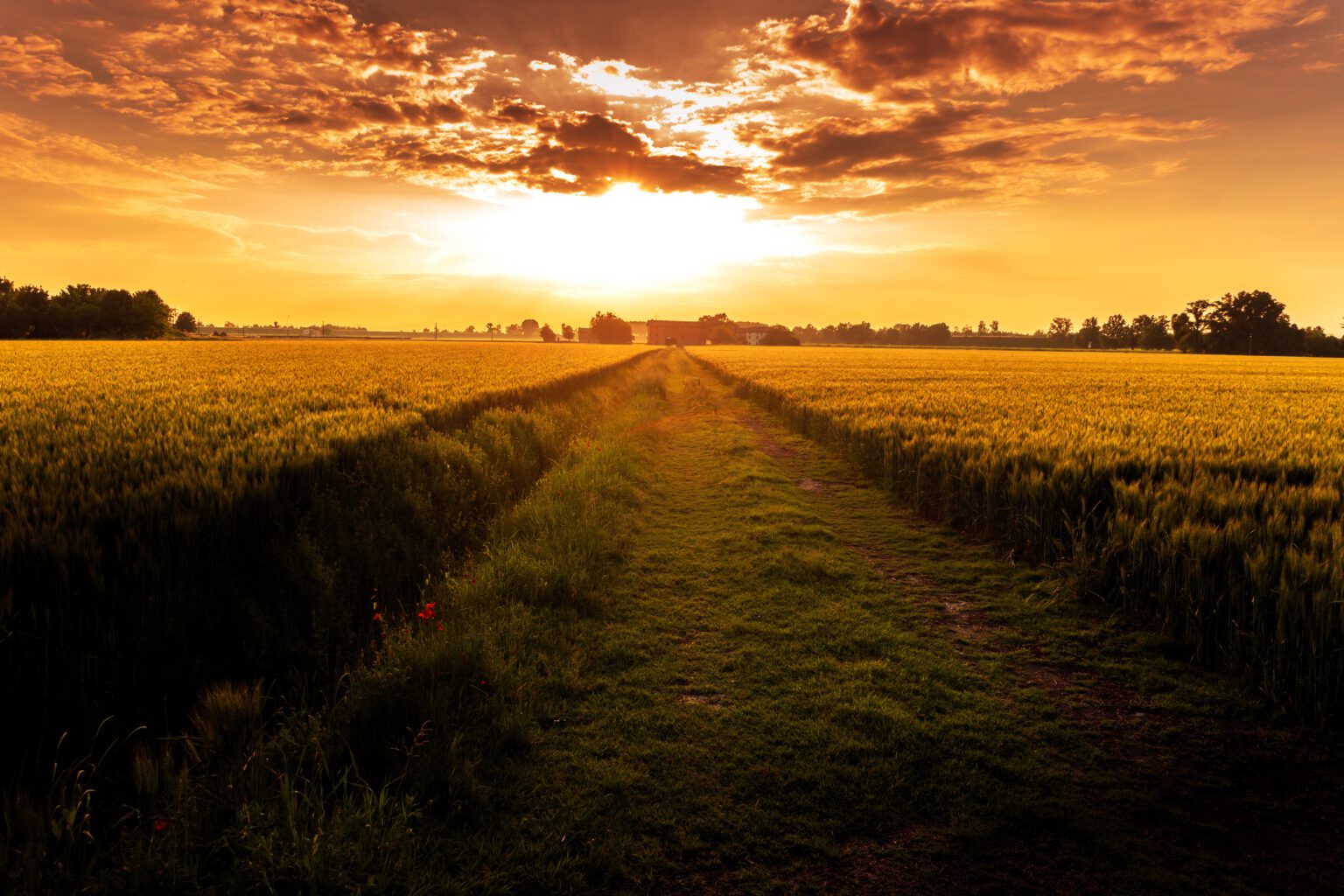
Impact on national economy
With the upcoming of international trade came an increase in demand for ‘luxury products’ like meat and butter, which gave a rapid increase to their prices.
With this increase in prices came an increase in the income of farmers. Mainly in the northern province Groningen, the farmers used this increase in income wisely by investing in innovations to make their labour more efficient, like machines, fertilizers, land drainage and steam pumping machines. However, these were mostly the small percentage of rich farmers, since the average farmer was a tenant of their land and did therefore not enjoy these profits. After 1880 numerous innovations were introduced and used on a large level, and the entire country started specializing in mainly the production of livestock products like dairy and meat, potatoes, manure, and grain, which was used for both human consumption and as fodder. The small farmers started innovating and introduced the first dairy factory; peasant started becoming the entrepreneur.
The impact of the agricultural economy on the national economy and the importance this plays can be found in an analysis of the trend of both economies. Up until 1870 agriculture had a central role in the Dutch economy. When the consumption of agricultural products stagnated and thus the sale of these products, the national economy decreased in an even trend. Many Dutch citizens had to rely on the agricultural sector for employment. Because of the high wages, farmers were reluctant to hire more employees. This resulted in a higher unemployment rate, which harmed Dutch economy. After 1880, the process of the modernisation of agriculture was started. New inventions, fertilizer, dairy factories and the upcoming corporations. After a period of recession, there was a great migration from the eastern provinces to the coastal provinces, which did not focus on agriculture as much. Because of this urbanization, a scarcity of employment in the agricultural sector came. However, this helped realize industrialization, because work normally done by employees, was now taken over by machines.
The 1880 to 1900s knew a great period of agricultural crisis. It is commonly acknowledged that this period of crisis was necessary for innovation in this sector. It was a wakeup call for all farmers who made an easy income and were comfortable in their methods, which is not positive for innovation. After this crisis, the agricultural labour force decreased drastically when a large part of the population moved to the coastal provinces. However, this decrease in the labour force led to a trend of production and productivity as it had never been seen before. The upcoming of new inventions and industrialization and the diversity in farming made the agricultural economy as we know it today.
Seeing these historical developments, it is clear that the evolution of the agricultural sector is closely linked to the national economy and the developing global market. The agricultural sector also has a big impact on employment. When there is a stagnation in employment opportunities in the coastal provinces, employment in the eastern agricultural provinces increases, which leads to decreased employment in the coastal provinces. In the end, the small farmers as entrepreneurs rise above the large companies and this leads to migration and urbanization. Even if the Netherlands still enjoys great agricultural export, it is not the main focus of our economy any longer.
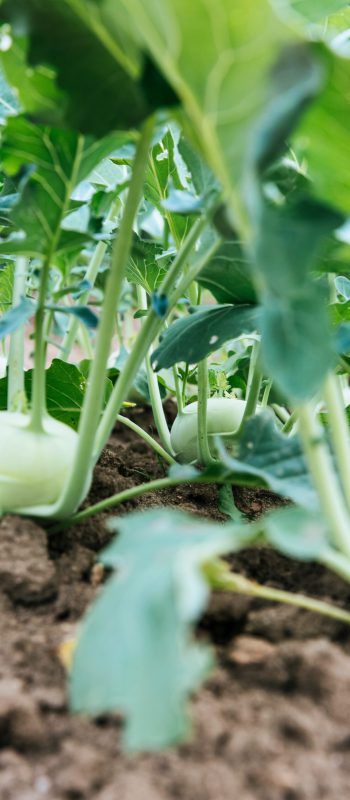
Current value in the national economy
The Netherlands is the export giant of Europe, being the second biggest agriculture exporter in the world!
The Importance of Agriculture in the Dutch Economy
Since the upcoming urbanization and industrialization, the importance of agriculture on the Dutch economy has never been as high as it was in the nineteenth century. The added value of agriculture consisted of almost 11 billion euros in 2019, which is about 1.4% of the gross domestic product (GDP) of the Netherlands. This volume of the GDP sees a rising trend: compared to 2009, this volume increased by 10% and the volume of 2009 compared to 1999 increased by 15%. The added value of agriculture is very volatile, mainly due to its sensitivity to the climate and the international food market.
Before 2009, the percentage of the agricultural market to the Dutch economy was deteriorating. However, due to the increase in the prices of food, this trend is seeing a small, but noticeable rise. While the contribution consisted of 1.3% in 2009, it grew to 1.4% in 2019. While this seems like a small percentage, it is above the European average. The average value of agriculture in one’s national economy in Europe is 1.1%. Comparing the Netherlands to its neighbouring countries, a significant difference can be noticed.
The image provided shows that the Netherlands is in fifth place amongst all European in the value of agriculture to the national economy. Their neighbouring countries, Germany and Belgium, have an added value of less than 0.5% in 2018.
The income of the agriculture sector has however lowered in the last twenty years. While the production volume increased by 25%, the high costs of energy, fodder and natural resources made it so that this income dropped.
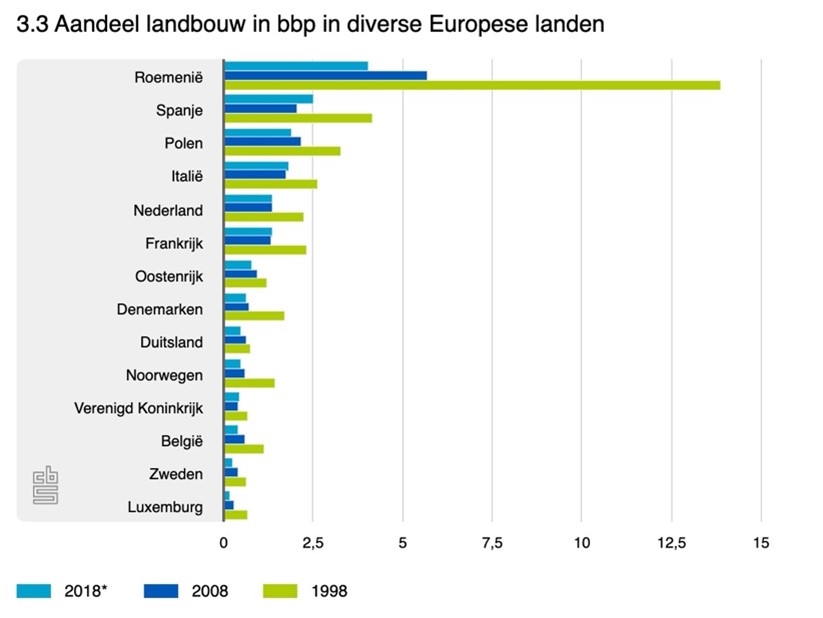
The Dutch agricultural system
The Netherlands is a big dairy producer, but 60% of the dairy consumed by Dutch citizens is imported from other countries.
Types of Agricultural Companies
At the end of the twentieth century, Dutch agriculture was one of the most productive systems in the world. The production volume in arable farming and horticulture rose above all other countries. This high productivity was possible because of the structural specialization the Dutch agricultural system knows.
In 2019, the agricultural sector knew 53 thousand companies, each having its specialization area. However, half of these companies focus on grazing cattle.
The different kinds of companies the Dutch agricultural sector knows are companies focusing on grazing cattle (mostly focused on dairy production), arable farming, horticulture, livestock, permanent crop production, normal crop production, crop/livestock combination and other livestock combination. The types of companies stated above are recited from most common to least common. Grazing cattle knows over 26.000 companies in 2019 and livestock combination companies know 235 companies.
In the production of plant-based products, the biggest production is in plants and flowers, followed by fresh vegetables, potatoes, and fruit. Dairy products know the largest production in products from the livestock market, followed by pork, beef, poultry and eggs.
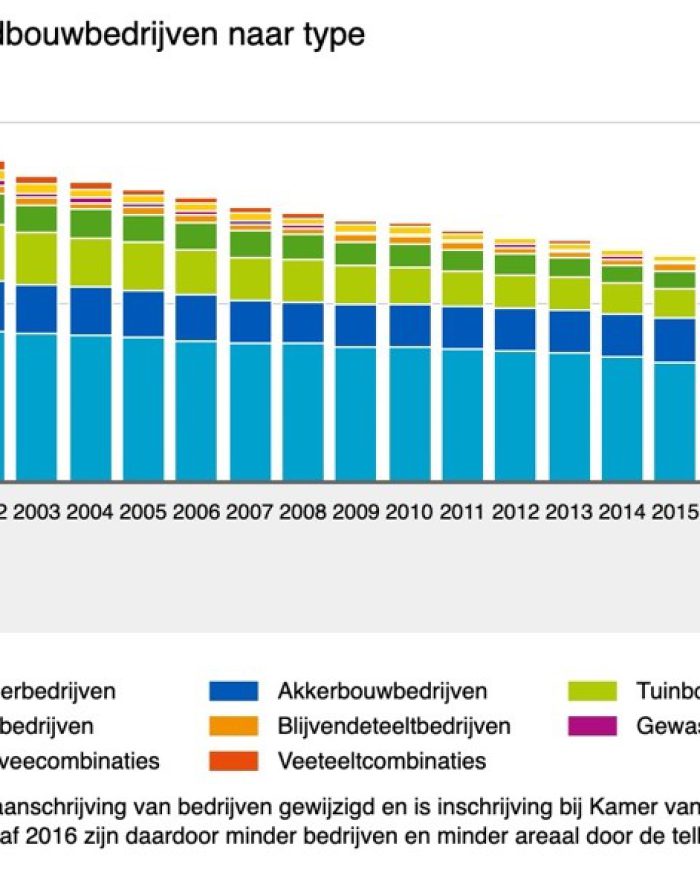
Government regulation and impact of climate change
Seeing the discussion of climate change and agriculture, the government tries to regulate the impact of these two on each other. This might cause a change in this structure, which has been relatively stable in the last twenty years. For example, the biggest nitrogen emission comes from dairy farming, which might cause a change in the structure of the agricultural sector. However, dairy production sees the largest number of agricultural companies in the Netherlands and is therefore one of the most important factors for the Dutch export of agricultural products.

Percentage of production for export and emport of dairy products
75% of the production of Dutch agricultural farmers is for export, while only 25% is used for national consumption. With the current eating habits of the Dutch citizens, a surface of 1800 square feet per person is necessary for the production of all demanded food. Over three-quarters of this surface is currently outside of the Netherlands. While the Netherlands is a big dairy producer, this is also used for export. 60% of the dairy Dutch citizens produce is imported from other countries.
Importance in export industry
Another important element of the Dutch agricultural system is its export. After the United States, the Netherlands is the biggest exporter of agricultural products worldwide. This position is due to the favourable circumstances for farming the Netherlands possesses. Loads of fertile soil, a nice climate and connections with the bodies of water. The harbour of the city of Rotterdam is beneficial to international trade and the export of products. Historically, it has been noticed that the export industry intensified after World War II. The upcoming population in Europe after the war resulted in an upcoming demand for agricultural products. Small farmers transformed their business into large-scale production of agriculture and livestock. The production volume increased and was mostly used for export to try and repair the damage the war had done to Dutch cities.
Climate change
The primary problematic human activity that contributes to climate change is the burning of fossil fuels, such as gas, oil and coal.
Percentage of production for export and emport of dairy products
Climate change has been a topic of concern for the last few decennia. Especially now, scientists urge action to be taken in fighting or trying to slow this climate change before it becomes irreversible. While some argue the issue of climate change is a hoax and it is just a natural shift in temperature, science has proven that human activity is the main factor in climate change. When looking at the relationship between Dutch agriculture and climate change, it is useful to go over what this issue of climate change means.
The primary problematic human activity that contributes to climate change is the burning of fossil fuels, such as gas, oil and coal. The burning of these fuels causes the emission of greenhouse gasses, which are heat-trapping gasses. These gasses raise the temperature of the earth. The main sectors causing these gasses are energy, industry, land use, buildings transport and agriculture.
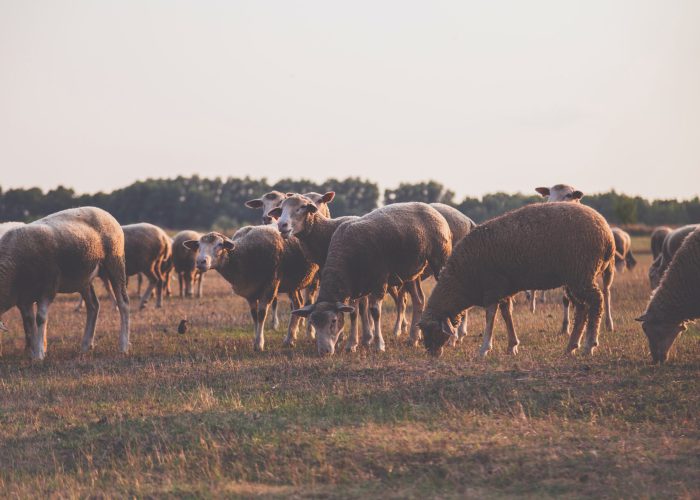
Percentage of production for export and emport of dairy products
The most damaging greenhouse gases to the climate are carbon dioxide and methane. These gasses are released with the use of gas and coal. In the public’s everyday life, we contribute to this emission. Driving a car releases gasoline, warming up a building uses coal, lighting up your house uses energy… Also factors larger than the general public result in the emission of these gasses. Clearing land in which forests are cut down releases carbon dioxide and decreases oxygen and agriculture and energy operations contribute largely to methane emissions.
Because of the technological advances of industrialization of the last century, the emission of greenhouse gasses has drastically increased. This has resulted in a raise of the average temperature on Earth of 1.1°C as opposed to before the industrial revolution, in the 1800s. While the average global temperature has risen by just over 1°C in 200 years, the average temperature in the Netherlands has risen by 2°C since 1900. In the last thirty years, a rise of the average temperature of 1.1°C was determined. It is remarkable how large the Netherlands exceeds the global average in the rise of temperature. This is important to remember when talking about the relationship between Dutch agriculture and climate change.
Importance in export industry
When people hear about the temperature rise, they might think this is a good thing: warmer weather in the colder seasons! Especially in the Netherlands, where the temperature in most seasons is relatively low, many people do not see the problem. However, this temperature rise is only the start. It has a big influence on other natural factors which can have dangerous consequences. For example, this is already leading to extreme droughts, water scarcity, wildfires, rising sea levels, floods, the melting of the polar ice caps, intense storms, and declining biodiversity.
The current nature of this problem can already be seen in the statistics of the increase in wildfires in the United States. Higher temperatures, droughts, and snowmelts have fueled wildfires in the United States. The duration of the wildfire season is extending and the damage that is done by the fires is deteriorating. This western part consists of highly populated areas such as the state of California. These people’s lives and homes are being threatened more and more by the danger of wildfires.

The impact of climate change on the Netherlands and future projections
Though the Dutch are experts in constructing dikes and dams to keep the water away from the cities, a rise in sea level will give a larger burden on these dikes, dams and flood barriers. Another cause of concern is the increase of salt water in the bodies of water. This salinization will create problems for the Dutch water supply used for agriculture, nature and drinking water.
Other than the rising sea level, other consequences of climate change can already be seen in the Netherlands. The percentage of annual rainfall has increased by 27% in the past century. Furthermore, more extreme weather conditions can be seen like heatwaves and intense storms. These extreme weather conditions caused an increase of 20% in water damage due to these storms. In July 2021, extreme floods caused heavy damage in the south of the Netherlands, as well as in Germany and Belgium. In 48 hours, there fell over 160 millimetres of rain, which caused the river de Geul to flood. This caused severe damage to houses and buildings and in Germany and Belgium, it even cost some human lives. These extreme weather cases with excruciating damages are the result of climate change.
The Royal Dutch Meteorological Institute (KNMI) published the anticipated possibilities for the future due to the results of climate change. Besides its estimation of the rise of the average annual temperature, it also estimates an increase in rainfall of 2.5% to 5.5%, as well as an increase in extreme weather conditions in all seasons. Furthermore, it suspects the possibility of an increase of heavy rain and hail and thunderstorms of 10 to 15% per extra degree. Lastly, periods of drought can be 5% to 25% stronger as opposed to the period between 1981-2010.
Thousands of scientists try to clarify the threat of climate change and try to make governments aware that action must be taken now. Reports from the United Nations showed that to avoid the worst impacts of climate change and maintain a livable climate for humans, a maximum rise of the global surface temperature of 1.5°C must be upheld. However, this is only 0.4°C from the current rise. These reports show that with the current policies that are in place, the global surface temperature will rise to 2.8°C by the end of the century. This is why action must be taken. Policies and regulations are set in place on national, European, and global levels. But how effective are these if the temperature will continue to rise?
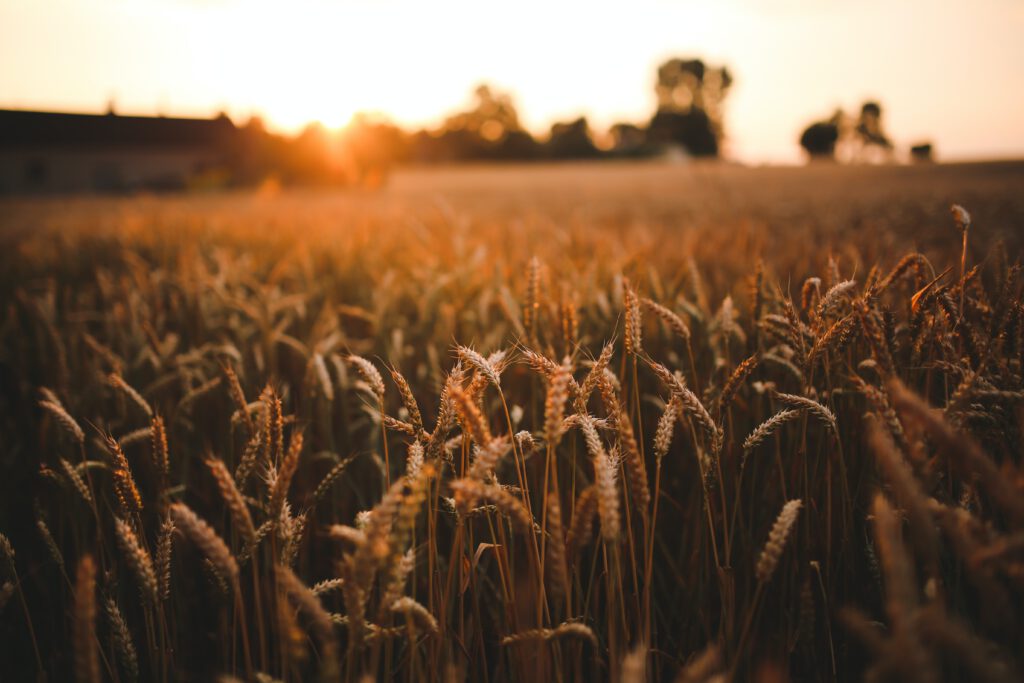
Percentage of production for export and emport of dairy products
For the Netherlands, the biggest concern is the rising sea levels. About 26% of the Netherlands lies below sea level, with the lowest point being in the city Nieuwekerk aan de Ijssel, which lies about 6.76 meters below sea level. Luckily, the Dutch are experts in building dikes and dams to protect the cities from flooding. However, it has been confirmed that climate change will result in rising sea levels. This is firstly because the rise of the global surface temperature due to greenhouse gas emissions leads to a rise in the temperature of the sea as well. The higher the temperature of the water, the more it expands and the more space it needs. The North Sea, which is the sea from the Dutch west coastal area, will most likely experience the consequences of the melting polar caps after 2050. The ice of the poles is slowly melting and wind up in the seas. The biggest concern is the uncertainty scientists have about the rate at which the sea levels will rise. The Royal Dutch Meteorological Institute (KNMI) suspects a rise of the sea level of between 30 centimetres to 1.2 meters by 2100. If no action is taken in disputing greenhouse gas emissions, the KNMI even considers a rise of the sea level of 2 meters. However, this probability is deemed low.
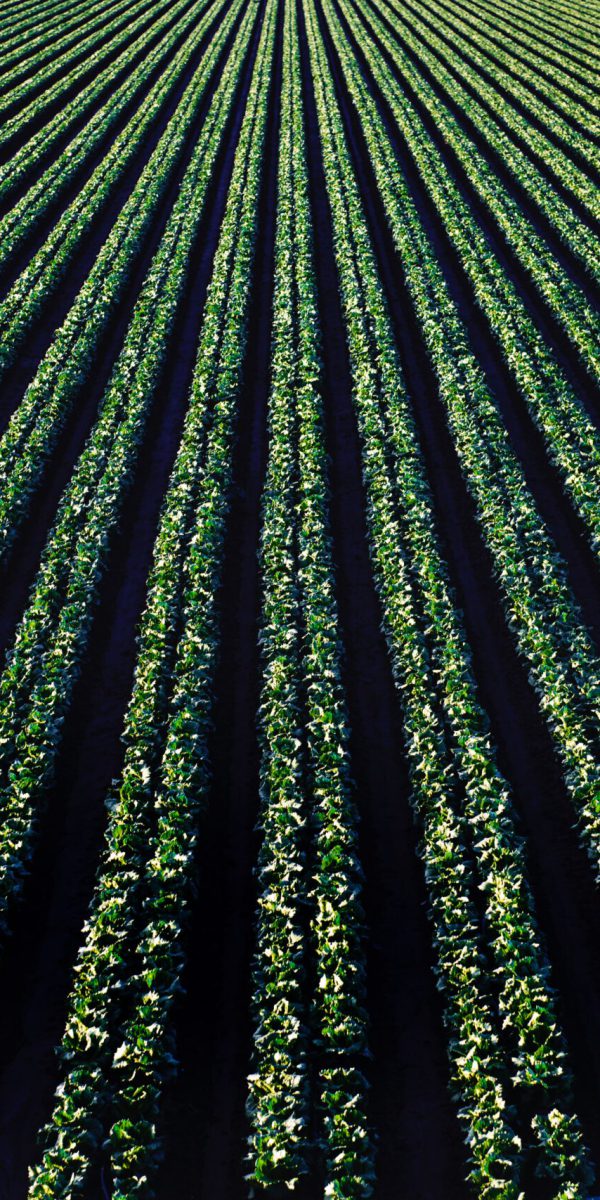
The Correlation Between Agriculture and Climate Change
Climate change increases the frequency and intensity of extreme weather events, such as floods and droughts, that can negatively impact agriculture.
Impact of Agriculture on Climate Change
In Dutch agriculture, methane (CH4) and nitrous oxide (N20) are the main emitters. Methane emissions come from livestock and their manure and nitrous oxide emissions come mainly from the fertilization of the soil. Carbon dioxide (CO2) is mainly emitted in greenhouse farming.
When analysing the statistics, all these different emitters are seen as one under the term greenhouse gasses.
The total emission of greenhouse gasses can be roughly divided into roughly three groups as shown below.
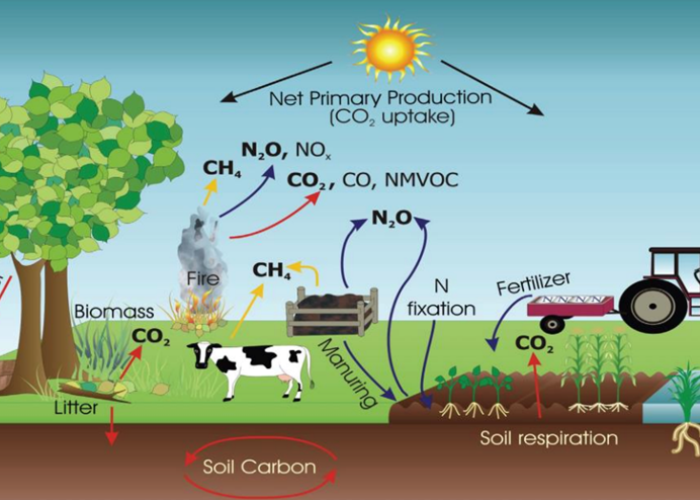
This group is responsible for half of the Dutch greenhouse gas emissions.
As for livestock, different kinds of livestock have different emissions. The biggest emitter is cattle, which produces roughly 70%, while pigs produce 20% and other livestock such as poultry produces 10% or less. Cattle is a grazing animal. It uses grass, which is not suitable for human consumption, and turns it into products which are suitable for human consumption, like dairy and meat. While this might sound efficient, the processing of this grass produces large amounts of methane, which ends up in the atmosphere through their manure. Besides this, fossil fuels such as gasoline and diesel are regularly used in livestock farming, which produce carbon dioxide. Furthermore, the high livestock density on Dutch farms leads to highly reactive nitrogen losses to air and water. The livestock density in the Netherlands is five times as big as the European average. Enhanced levels of nitrogen in the air, soil and water can have dangerous consequences for human health. This can also lead to decreased biodiversity and pollution of drink- and groundwater.
Manure management and the way it is stored contributes to the emission of both methane and nitrous oxide. In manure storage, bacteria break down certain parts of manure and when no oxygen is provided, it will convert this to methane. Manure from poultry produces nitrous oxide in storage.
This group is responsible for a rough quarter of the total emissions.
The cultivation of crops and grass is crucial for human consumption. Greenhouse gas emissions from soil come mainly from a process which takes place in the soil, which converts nitrogen to nitrous oxide.
The biggest sources of emission in soil are fertilizer with 24%, manure with 23%, followed by manure from meadows due to the grazing process which contributes 19%. However, the emissions from soil have drastically decreased from 1990 on. This is mostly due to the lower use of fertilizer, a lower emission from the meadows because of a decline in grazing and a lower emission of ammonia.
This group is responsible for a quarter of emissions due to their energy consumption.
The main factors in the emission from greenhouse farming are the high consumption of natural gasses to heat the greenhouses and the generation of electricity. The amount of consumption is dependent on the outside temperature. The Netherlands knows many greenhouses due to its great export of flowers, such as chrysanths and tulips. Greenhouse gases have a share of 80% in the energy consumption of the entire agricultural sector. Greenhouse farmers started using gas engines (WKK) to generate heat and electricity and sell a portion of this generated energy. This energy consumption is a problematic contributor to climate change due to its high emission of carbon dioxide.

Impact of Climate Change on Agriculture
So, while the agricultural sector contributes to climate change, there are other factors involved as well. The entirety of the consequences of climate change harms agriculture as well. While governments try to regulate sustainable agriculture to decrease the emissions caused by agriculture, these regulations should also try to improve the resilience of agricultural ecosystems. The agricultural sector is one of the most vulnerable economical sectors to climate change in the European Union. The IPCC of the United Nations argued in their report that there are both positive and negative impacts on food production. These impacts are due to the changes in certain factors that climate change causes. These changed factors are listed below.
The increase in precipitation will result in a need for a shift in the irrigation and cultivation process. Changes in the period of flowering and growing of crops will have a direct impact on the crop yield; the changes in periods will change the labour force on the farm.
The increase in temperature makes an extension of the growing season. This has the positive result that certain annual crops can be grown for a longer period which increases crop yield. The negative result this has is that this temperature can cause heat stress on certain crops and makes the cultivation of certain crops that need a colder climate harder. Farmers will also need to take repercussions to prevent heat stress in their livestock. They might need to take measures such as ventilation, shade and extra drinking water.
This increase in the occurrence of extreme events will have a big impact on the variability of crop yield. This increase in extreme weather events has been confirmed by an IPCC report in 2018.
The rise in sea level increases the risk of flooding coastal areas and other areas close to bodies of water. The consequence of this could be the salinization of the soil, which decreases the agricultural potential of these areas.
The changes in environmental conditions like an increase in heat and humidity affect the fodder and grass. This will have an impact on herd management and the feeding regime of livestock. The grazing period will change and complementary food and water might have to be provided.
The increase in CO2 might cause an increase in the produce yielded from the C-3 plants, such as wheat. However, this will have little impact on other crops. The use of C-4 plants such as maize is already maximized.
Regulations
On both international and national level, regulations have been determined in deteriorating the emission of greenhouse gasses.

European Union Targets and Paris Agreement
Earlier on, the European Union member states set a target based on the Paris Agreement for at least a 25% reduction by 2020. Because it is up to the member states which measures they will take to achieve this goal, a big responsibility lies with these member states. The Netherlands however, failed to effectively implement regulations to try and meet these targets. This is why climate organisation Urgenda sued the Dutch government for their lack of implementation of these European targets, which was successful. In this ground-breaking case, the courts strongly encouraged (almost forced) the Dutch government to do their utmost best to meet these targets. It seemed like emissions were reducing and the target was met, however, this was mostly due to the Covid-19 regulations. After the lockdown, emissions went up again and thus the government failed in meeting this reduction of 25%. With these new targets for 2030 and the supervision of the courts and organisations like Urgenda, it seems like the Dutch government is now actually trying to achieve these goals. This ambition can be seen in the fact that the Netherlands, amongst a small group of other European countries, tries to raise the European reduction target to 55%. Originally, the European Union set this target for only 40%, however, this is not in line with the maximum of 1.5°C decided in the Paris Agreement. This proposition was accepted by the new chairman of the European Commission.
The national climate goals and policies are established in the Dutch Climate Act. This Act states the following emission goals:
For 2050, a reduction of 95% as opposed to 1990 for greenhouse gas emissions in the Netherlands
For 2030, an interim target of a reduction of 49% is set
For 2050, the production of electricity must be 100% carbon dioxide (CO2) neutral
In this Climate Act, it was decided a plan must be made by the government, consisting of the policies with which the government plans to achieve the goals set in the Climate Act. It also must give insight into the scientific view on climate change, as well as the impact the policies can have on the national economy.
This climate plan covers all areas which have a negative impact on climate change, however, we will only discuss the area of agriculture and land use.
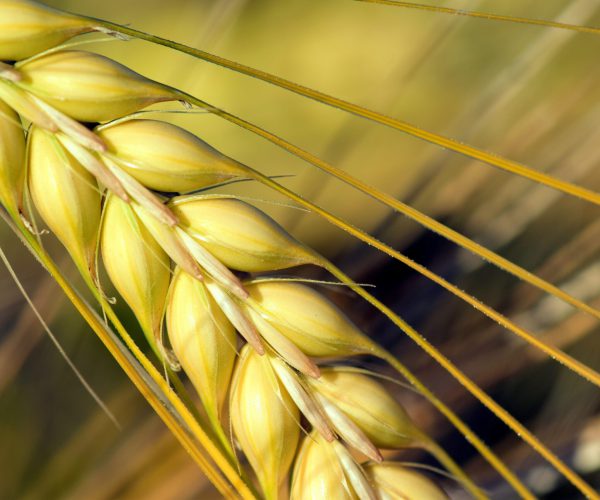
Action Programs
Besides all the subsidy opportunities, the government introduced multiple action programs, such as the ‘Action Programme Climate Adaption Agriculture’ and the ‘Action Nitrogen’ plan.
The Action Programme Climate Adaption Agriculture focuses on five pillars:
A well-oiled water system will help farmers battle droughts and floodings. The farmers, regional water authorities and nature conservation management will regulate as a team how to make sure water is stored more efficiently.
Good soil is crucial to farmers; this will make sure their crops will grow efficiently and healthily. The soil must be able to withdraw water and nutrients. Farmers must plough their lands less frequently, use lighter machines and root their crops deeper.
Extreme weather conditions can damage the farmers’ crops, by for example hail frost or diseases which result from these conditions. Measures must be taken to better protect the farmers’ crops. Cultivation caps are one of these measures which will protect the farmers’ fruits as well as select different kinds of crops which are better at withstanding more extreme conditions.
Livestock such as cows, pigs and chickens may suffer from the heat and droughts and the possibilities of new diseases. The protection of these animals can be enforced through the innovation of the stables, by for example inserting cooling systems and offering shade in the meadow.
A partnership between farmers, regional water authorities, municipalities and provinces is encouraged to find regional solutions to better protect agriculture from the dangers of climate change. The government offers many subsidies on grounds of innovation.
All these regulations imposed by the government are meant to encourage farmers to start sustainably farming on their account, instead of forcing them into certain actions. If it appears these regulations are not effective, other measures might have to be taken, including implementing sanctions for farmers who fail to meet individual targets, however, this has not yet been determined seeing the recent publishing of these regulations. However, the government has received a great deal of criticism and intense protest from farmers who argue that most regulations to try and decrease greenhouse gas emissions are focused on agriculture instead of other sectors.
International and National Climate Regulations
The Dutch government is taking the necessary measures to protect its citizens from the effects of climate change. On both international and national level, regulations have been determined in deteriorating the emission of greenhouse gasses.
The Netherlands is bound to European regulations and must adapt these targets to their national litigation. All member states of the European Union signed the Paris Climate Agreement in 2016. This binds the Netherlands to the minimum targets set by this agreement. The purpose of this agreement was to prevent the global surface temperature from increasing to 2°C and aiming for a maximum of 1.5°C. To meet these targets, all European member states agreed to take all necessary measures to make this happen and set a target of reducing emissions from the entire European Union by 55% in 2030. Furthermore, the European Union strives to be climate neutral by 2050, which means there are Net-Zero emissions. Net-Zero emissions are achieved when either no greenhouse gasses are emitted or the emission caused by greenhouse gases is compensated by the production of other gasses, such as planting extra trees to produce more oxygen. The Paris Agreement consists of plans which cover 100% of all global emissions if executed effectively. The urgency of striving for a climat- neutral society is now acknowledged by more and more countries across the globe. Even countries like Canada, Chili, Costa Rica and New Zealand bound themselves to Net-Zero emissions by 2050.
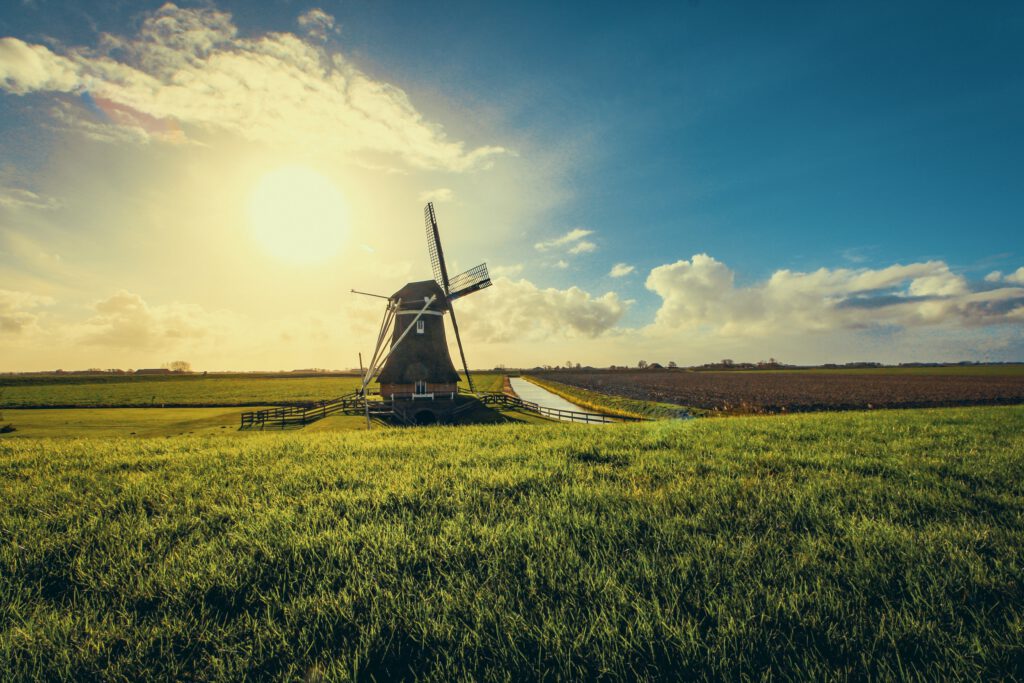
Agricultural Sector and Greenhouse Gas Emission Reduction
To achieve the goals of the Dutch Climate Act for 2030 and 2050, the emission of greenhouse gasses in agriculture must be drastically reduced. Making the agricultural sector climate neutral is rather tricky since certain emissions are a part of agriculture. Livestock produces methane and produces nitrous oxide. Both methane and nitrous oxide are generally seen as carbon dioxide emissions, which is the primary greenhouse gas produced.
The goals for specifically the agricultural sector set by the government are:
A reduction of 5 megatons for emissions caused by livestock farming
A reduction of 1 megaton for emissions caused by greenhouse horticulture
A reduction of 0.4 to 0.9 megatons for emissions in peat meadow areas
Regulations Instated by the Government
The policies regarding the reduction of emissions caused by agriculture are linked to the necessity to make food production and consumption more sustainable. The most important regulations the government instated based on these policies are:
The encouragement of the government for farmers to exercise a method of ‘circular agriculture’. In this method, the residue of one chain of farming is re-used as a resource for another chain of farming. To realize this method, a transition must be made in which plant-based and animal production are linked. For example, in this method, a certain residue of crops used for plant-based production is normally categorized as unusable. To this residue, insects will be added which will transform it into fodder for the farmers’ livestock. Thus, the part of production which is normally not suitable for human consumption, now contributes to other productions which are suitable for human consumption, such as the milk, eggs and meat these animals produce. The government tries to stimulate the use of this method by subsidizing innovations and investments for this ‘circular agriculture’.
In reducing emissions in livestock farming, the government distinguishes two different sources of emissions: emissions from the livestock themselves and emissions from the animals’ manure. Managing manure will help to decrease methane emissions while managing livestock will result in a reduction of odour nuisance and the emission of ammonia and particulate matter. This is why regulations have been made to optimize fodder and improve the processing of manure. To promote this, the implementation of a sustainable fermentation process, which reduces the methane emissions caused by this process, will be subsidized. This subsidy programme will be elaborated in the programme ‘Action Nitrogen’, which is being drafted right now.
Besides this, subsidies are available for farmers who start implementing low-emission stable systems. These systems are based on innovations which help reduce the emission of nitrogen these stables normally produce. The government will facilitate the farmers in the process of applying these new systems. Lastly, the government will support the process of so-called ‘warm sanitation’, meaning the reduction of the production of pig farming. The government hopes their support in closing pig farms will lead to a reduction of pigs in the Netherlands.
The government wants to reduce CO2 emissions caused by land use from peat meadow areas by aiming for sustainable management of all Dutch agricultural soil by 2030. Right now, pilots are being produced which are testing if an increment in the water level in these areas will help reduce these emissions. However, based on the Climate Agreement, the government installed arrangements for expanding the acreage nature reserve. Furthermore, regulations are set in place to restrict deforestation and the plantation of new trees to increase the oxygen levels in the area.
For greenhouse farming, a CO2 ceiling has been determined. The program ‘Greenhouse as Energy Source’ supports the transition to more sustainable greenhouse farming. Currently, this sustainable process is being researched to determine what methods are most effective. As of now, possibilities lie in implementing systems of carbon storage or reusable new energy sources. The ambition is that greenhouse farming will be climate neutral by 2040.
Another possibility to reduce emissions the government tries to encourage farmers to implement is an increment in growing sustainable plant-based protein sources. When farmers will realize this, the Netherlands will be less dependable on non-sustainable plant-based protein sources from outside the European Union, such as soy. While soy is used for human consumption, it is mostly used for fodder. When growing soy, farmers must participate in a form of deforestation to realize the supply of soy European countries asks for. These soy farms are mostly in South America. The Dutch soil sees opportunities for growing beans, peas and clover. However, the government has not yet determined the right alternative for soy in fodder.
Lastly, regulations have been made for food consumption and food waste, which are mostly aimed at citizens. Arrangements have been made with companies and organisations to reduce their food waste, as well as to promote the reduction of food waste to the public. A gentle balance must be found for food which is sustainable, healthy, and affordable, and consists of a healthy balance of both plant-based and animal-based proteins. Sustainable meat and plant-based alternatives must be promoted. 2023 will mark the fifth year in which the Week Against Food Waste will be organised. This initiative helps promote the problem of food waste and makes the public more aware of this problem.
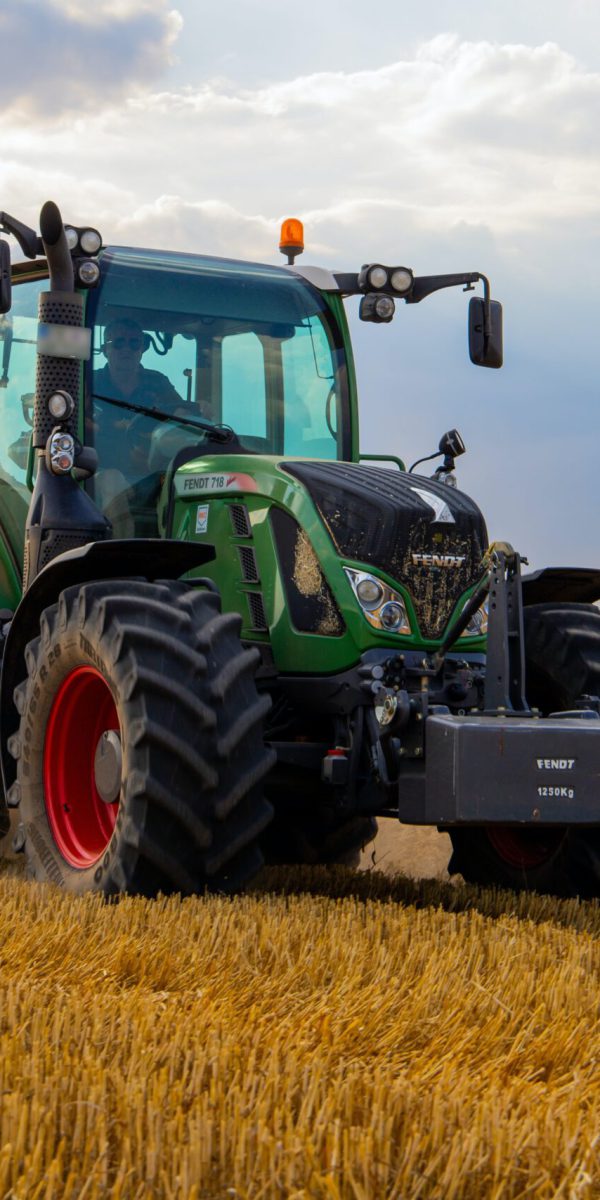
Effectiveness of the Regulations
One of the points of criticism argued by academics is that de entire regulation system in the Netherlands concerning agriculture and climate change is based on voluntary action.
Predicted Emission Reductions
Scientists from the University of Wageningen recently released their research on the expected reductions in emissions in agriculture, based on the current regulations. Their prediction was for 2030 and 2040.
For methane emissions, it is predicted that with the current regulations, emissions will reduce by 4,7% in 2030, as opposed to 2020 and in 2040 a reduction total of 5,4% as opposed to 2020.
Nitrous oxide emissions are predicted to reduce by 9.3% in 2030 as opposed to 2020 and by 2040 a reduction of 12,04% as opposed to 2020.
Ammonia emissions will reduce by 8,4% by 2030 and 14,01% by 2040 as opposed to 2020. These numbers are rather uncertain because of the great discussion on the effectiveness of the regulations regarding livestock, specifically livestock such as poultry.
Carbon dioxide emissions due to liming agents will barely see any reductions. Some reductions will take place due to a decline in agricultural land areas. By 2030, a reduction of 3.3% is predicted and by 2040 a reduction of 6.78% as opposed to 2020.
Nitrogen emissions will reduce by 10,3% by 2030 and the total reduction as opposed to 2020 will be 12,55% as opposed to 2020.
Other scientists have determined that to reach the goals set in the Climate Agreement, a reduction of approximately 70% needs to be reached in some areas of the agricultural sector. Realistically, the government aims for a 50% reduction by 2030. Based on this research, the total emission will approximately see a 36% reduction by 2030. However, this is when everyone complies with all regulations. Climate neutrality by 2050 will likely not be reached if the trend based on this research will realize itself.
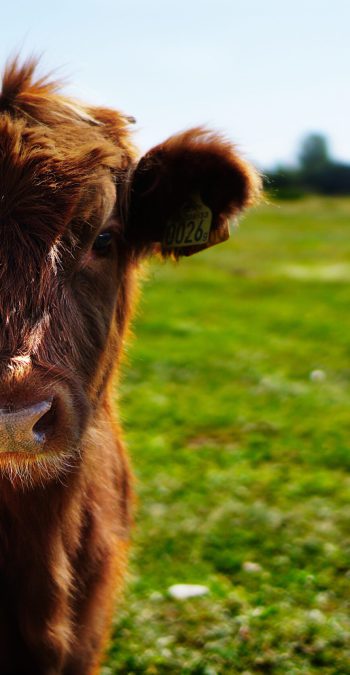

Criticisms and Shortcomings of Current Regulations
Change needs to happen if the goals want to be reached. Realistic and strictly enforced regulations need to be set. The literature, experts and even politicians have their take on the effectiveness of the regulations imposed by the government. Their points of criticism will be briefly discussed. After this, a few solutions will be proposed.
One of the points of criticism argued by academics is that de entire regulation system in the Netherlands concerning agriculture and climate change is based on voluntary action. When farmers want to partake in innovative sustainability projects, tons of subsidies are available. The regulations leave a lot of room for interpretation, which is why even when farmers take the government up on participation in these projects, it is not as sustainable as it was meant to be.
However, after evaluation of the regulations, it has been determined that not that many farmers make use of these subsidized projects. Both the Dutch government and the Paris Climate Agreement think they can realise their goals with a voluntary approach. They want to encourage, rather than punish and use legal methods to bind farmers to certain emission rates. However, this legally binding is deemed to be necessary if the climate goals want to be achieved through sustainable farming.
Political Disagreements and Ineffectiveness of Partnerships
Besides the criticism in literature, there is criticism in politics as well. While the government decided on the current agricultural regulations, multiple parties in parliament do not agree with this approach. The minister for Nature and Nitrogen spoke about her determination that more must be done. She argues that studies show that to reach the emission goals from the Paris Climate Agreement, in some areas of the provinces Gelderland and Noord-Brabant, nitrogen emissions must decrease from 70% to 80%. This is why 400 members of the political party VVD, which has a majority of seats in parliament, have filed a motion to distance themselves from the current nitrogen policies regarding farmers. They demand a new solution is found, since the current regulations will not be effective enough to reach the emission reduction goals.
One of the biggest points of criticism on the current regulations is that they are mostly based on theoretical models and calculations, instead of current facts and reachable goals. This is why a project was introduced in which farmers were asked what reachable, effective innovations they had applied to make their way of farming more sustainable. In a debate in the Dutch House of Representatives, many politicians argue they started too late in enforcing regulations to reduce emissions. One of the politicians even states that if nature was a patient in a hospital, the doctor would say there was only a 20% chance of a full recovery.
Other politicians argue that the current regulations seem to focus on decreasing the number of farmers, instead of decreasing nitrogen emissions. Furthermore, most politicians argue that economic consequences need to be considered. This field is currently relatively uncertain, which is causing agitation between farmers.
The partnership between farmers, municipalities, and provinces the government tried to encourage through subsidies, has been ineffective. The goal of this was to find regional solutions targeting reducing the emissions did not achieve any results. The different parties keep disagreeing. This is why the chairman of this Agricultural Agreement (LTO) has released a statement saying it is up to the government now to create solutions and realize new regulations. The Agricultural Agreement has helped in a way in which the government now knows what transitions farmers can bear and what their expectations are. Based on this, the government will be able to take effective measures.
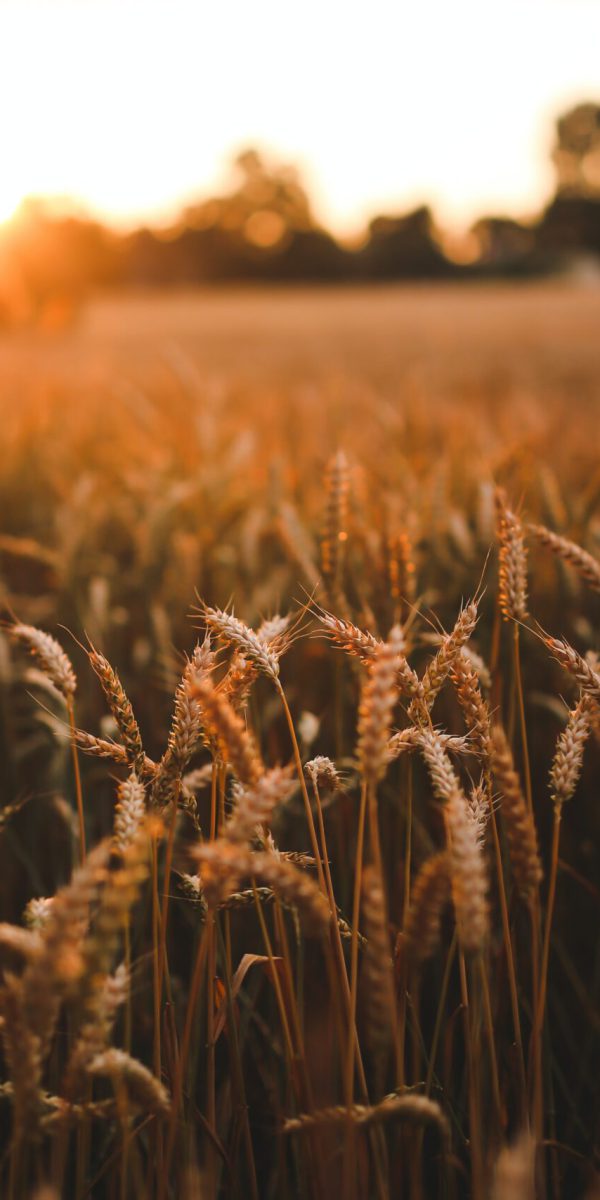
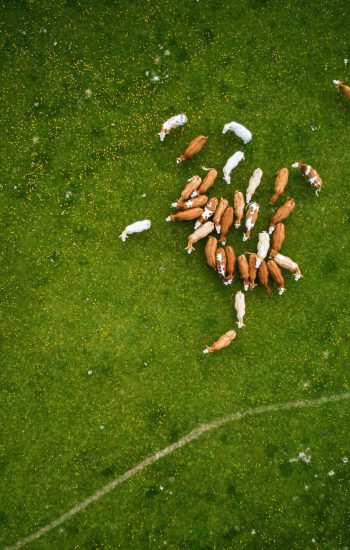
Proposed Solutions for Improved Regulations
Experts in the field of nitrogen have recently released their research on the current regulations, by order of the Minister of Nature and Nitrogen. They argue the current regulations are way too broad and unclear to the individual farmer. They propose a clear emissions cap. This way, it is clear for the individual farmer how much nitrogen is allowed and they can all decide on which transformations they will realize to reach this target. This emissions cap can be determined on a national or regional level. The experts prefer a national approach since this is easier to realize; however, it is up to the government to decide this, in consultation with the farmers.
Furthermore, these same experts propose areas in which a very limited amount of emission is permitted. Examples of these buffer areas are the Veluwe, a huge area of nature in the eastern provinces of the Netherlands.
The most important thing, according to these experts, is clarity. If a strict norm in emissions is realized, some farmers will have to reduce more and thus make more changes in their current practice as opposed to others. A regional approach will be more effective and affordable, but a national approach can be instated earlier, which is critical seeing our current state and the goals set for 2030. With transparency and clarity from the government regarding farmers, the consequences and expectations of the regulations will be comprehensible. This way, farmers will be more reluctant to comply with the regulations, hence they will be more effective.
Innovative Farming Practices and Sustainability
For regulations to be effective, they must be complied with. Regulations can be effective in theory as to reaching a certain goal, however, if they are not lived up to, they won’t be effective. A research project argued the issues with current regulations as they were seen by the agricultural sector itself. Through interviews with multiple farmers, this project argued why the current regulations are not effective. With this, the project shows certain solutions.
One of the proposed solutions is targeting the issue of a lack of coherency and continuity. The emission problem and climate change are a nationwide issues, not only an issue for the agricultural sector. With the regular changes in government, regulations are proposed but are adjusted and taken over by other politicians. It lacks clarity and coherency, as other experts argued above. Furthermore, all current solutions are based on a short period. It is unrealistic and unreasonable to expect these short-term goals, which raises agitation among farmers. By regulating long-term solutions and determining actual numbers of reduction in for example livestock, farmers can move towards these targets in their way.
Other than this, a regional approach seems most effective. Current policies are based on a national approach, which ignores the regional differences. For some areas which are surrounded by large nature territories and where intensive companies are based, a larger reduction of emissions is expected with these current regulations. A more regional approach, taking geography and customization into account, will increase the effectiveness of the regulations.
A personal approach seems most effective. By generalising the entire agricultural sector, a lot of factors are disregarded. For some farmers, their entire method of farming will have to change. With livestock farmers, a reduction of their livestock is necessary. Other farmers will have to focus on new technology and innovation. Possibilities in innovation are for example; adding more water to fertilizer, less protein in fodder, more grazing areas for cattle, breeding for fodder efficiency that results in less ammonia emission and the use of a fertilizing application which shows the ideal time for fertilization.
Solutions like circular agriculture and sustainable farming could be effective, but not in the way they are regulated now. There must be a willingness to transform to these methods under farmers. Theoretically, these are effective methods to decrease emissions, however, farmers will have to be willing to let go of their profit margin for the well-being of nature. The government will have to find a way to encourage these methods if it wants to introduce them in itts regulations. Only if farmers are willing to realize these methods, will it truly be effective.
For the project of Agricultural Sustainability, and Sustainable Development of the Ministry of Economic Affairs, three farmers were questioned, each from a different specialization of farming of the highest emitters in agriculture (a dairy farmer, an arable farmer and a tomato farmer). This interview showed their take on the impact of agriculture on climate change and the arrangements they made to increase sustainability in their way of farming. This interview has been summorized and is presented down below.
The fodder of cattle mostly has a high protein level, which will increase the level of nitrogen in the fodder. This results in the emission of ammonia, methane and cyanide in manure storage when the manure starts decaying. This farmer only feeds his cattle fodder with a high carbo-to-nitrogen ratio and add the necessary bacteria which prevent the decaying process. This prevents the emission of ammonia and methane. The consequence of this is that it is more expensive to make for example a litre of milk, however, this farmer believes it improves the content of it and that this sustainable way of farming brings more satisfaction.
He argues modern arable farmers must maintain the method of ‘precision farming’. In collaboration with the University of Wageningen, he designed a navigation system and software, which distinguishes the different kinds of soil and its purpose. With the help of GPS, an accurate route can be determined which leads to precise fertilization. This preserves gasoline, seeds and pesticides. However, there is no possibility for the preservation of manure.
Energy is a big expense, which is why the focus is generally on energy conservation. This farmer uses a closed greenhouse system, heat-cooling storage which provides both heating and cooling in the greenhouses. This company also just recently started using geothermal technology for heating. Because of the introduction of these innovations, heat input has decreased by 50%. The sustainable way of heating through geothermal technology means less fossil fuels have to be used which means a decrease in CO2 emission.

What can you do?
Reading all this, it is understandable to be frustrated with the Dutch government. How did they let it get this far and why are they not taking effective measures? While it is up to the government to make sure that not only the agricultural sector, but every other contributing sector decrease their greenhouse gas emissions, there are possibilities for you, as a citizen of the Netherlands, to help your little country reach the emission goals set by the Climate Agreement.
So, what can you do? Every contribution, no matter how little, is better than none at all. While you think it might not make an impact, we all start somewhere. Minor changes you can make in your everyday life consist of:
Upgrade the isolation in your home. Especially houses from before 1975 have poor isolation. With better isolation, less energy will have to be used to heat your home. Both the climate and your energy bill will thank you. There are even possibilities for subsidies.
While solar panels on individual houses are expensive and are not yet proven to be the solution, there are other possibilities for climate-friendly green energy. When considering this, use this comparator to determine which green energy best fits your home.
The NS, a public transportation service, drives on green energy. While it might be easier to take your car, gas prices are expensive nowadays. Instead, consider public transport to get to your destination. The benefit of public transport is less traffic and the time to make your transportation time useful, by relaxing, studying or working. As a student, free public transport is available. Other than this, there are possibilities of receiving a discount if you are a frequent traveller.
Consider travelling by train instead of by plane. In Europe, an effective train route travels through most countries. Of course, some distances are not realistic to travel by train and yes, it would take longer. However, distances shorter than 750 kilometres are easily accessible with public transport. Flying takes longer than only the flight time. Arriving at the airport two hours in advance, waiting for luggage after your flight; it might still take longer when travelling by train, however, the difference won’t be as big as you’d think.
Be aware of the objects and appliances you own. Old appliances will use more energy and are way less environmentally friendly as opposed to the new models. If you have the finances to consider this, it might be worth it. Besides this, consider fixing your appliances before throwing them away and buying new ones. Loads of CO2 emissions come free from the process of manufacturing certain appliances, and it will save money. Besides this, the process of manufacturing clothes is not environmentally friendly. Consider thrifting instead of constantly buying new clothes and consider: do I really need new clothing?
Consider trading the meat you eat for a plant-based option, even if it is only once or twice a week. With the agricultural sector being a big emitter as has been established on this website, livestock has a big contribution to this. By choosing plant-based options, a big change will be made to the demand of meat and thus the supply and production of livestock.
While you might think you as an individual won’t make an impact, human behaviour is contagious. If you eat plant-based options a few times a week, your roommates might join you. When you travel by public transport, your travel or work friends will travel with you. Thrifting together is just as fun as shopping in fast fashion stores, if not more fun. So always remember: the change starts with you!
Besides these lifestyle changes, you can visit the website of the climate organisation Urgenda. They proposed 54 solutions to reduce emissions in the Netherlands, for both the government and you as an individual.
Lastly, use your constitutional and democratic rights and speak up against the government. The voice of the people is of the utmost importance. Speak up, protest and make sure the government knows what the citizens really want.
Made by:
Jade Windsant
